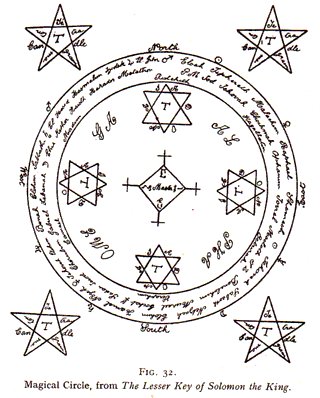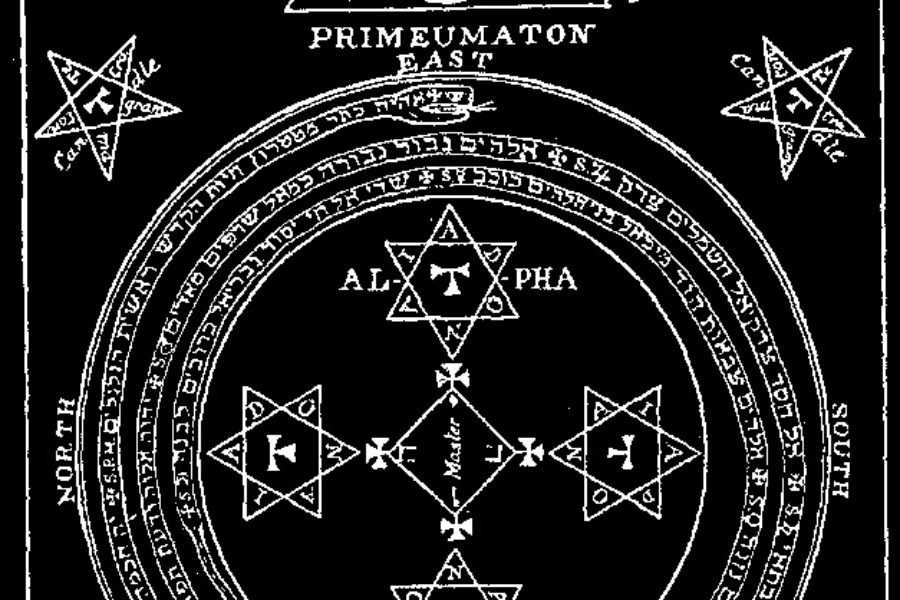The Lesser Key of Solomon or Clavicula Salomonis , is an anonymous 17th-century grimoire, and one of the most popular books of demonology.
It appeared in the 17th century, but much was taken from texts of the 16th century, including the Pseudomonarchia Daemonum, by Johann Weyer, and late-medieval grimoires. It is likely that books by Jewish kabbalists and Muslim mystics were also inspirations. Some of the material in the first section, concerning the summoning of demons, dates to the 14th century or earlier.
The book claims that it was originally written by King Solomon, although this is certainly incorrect. The titles of nobility (such as the French Marquis or Germanic Earl) assigned to the demons were not in use in his time, nor were the prayers to Jesus and the Christian Trinity included in the text (Solomon’s birth predated Jesus Christ’s birth by more than 900 years).
 The Lesser Key of Solomon contains detailed descriptions of spirits and the conjurations needed to invoke and oblige them to do the will of the conjurer (referred to as the “exorcist”). It details the protective signs and rituals to be performed, the actions necessary to prevent the spirits from gaining control, the preparations prior to the invocations, and instructions on how to make the necessary instruments for the execution of these rituals.
The Lesser Key of Solomon contains detailed descriptions of spirits and the conjurations needed to invoke and oblige them to do the will of the conjurer (referred to as the “exorcist”). It details the protective signs and rituals to be performed, the actions necessary to prevent the spirits from gaining control, the preparations prior to the invocations, and instructions on how to make the necessary instruments for the execution of these rituals.
The several original copies extant vary considerably in detail and in the spellings of the spirits’ names. Contemporary editions are widely available in print and on the Internet.
The Goetia: The Lesser Key of Solomon the King is a 1904 translation of the text by Samuel Mathers and Aleister Crowley. It is essentially a manual that purports to give instructions for summoning 72 different spirits.
The Lesser Key of Solomon is divided into five parts.
Ars Goetia
The first section, called Ars Goetia, contains descriptions of the seventy-two demons that Solomon is said to have evoked and confined in a brass vessel sealed by magic symbols, and that he obliged to work for him. It gives instructions on constructing a similar brass vessel, and using the proper magic formula to safely call up those demons.
It deals with the evocation of all classes of spirits, evil, indifferent and good; its opening Rites are those of Paimon, Orias, Astaroth and the whole cohort of Infernus. The second part, or Theurgia Goëtia, deals with the spirits of the cardinal points and their inferiors. These are mixed natures, some good and some evil.
The Ars Theurgia Goetia is the second section of The Lesser Key of Solomon. It explains the names, characteristics and seals of the 31 aerial spirits (called chiefs, emperors, kings and princes) that King Solomon invoked and confined. It also explains the protections against them, the names of their servant spirits, the conjurations to invoke them, and their nature, that is both good and evil.
Ars Paulina
The first chapter refers on how to deal with the angels of the several hours of the day (meaning day and night), to their seals, their nature, their servants (called Dukes), the relation of these angels with the seven planets known at that time, the proper astrological aspects to invoke them, their names (in a couple of cases coinciding with two of the seventy-two demons mentioned in the Ars Goetia, the conjuration and the invocation to call them, the Table of practice.
The second chapter concerns the angels that rule over the zodiacal signs and each degree of every sign, their relation with the four elements, Fire, Earth, Water and Air, their names, and their seals. These are called here the angels of men, because all persons are born under a zodiacal sign, with the Sun at a specific degree of it.
Ars Almadel
This section contains a collection of prayers (some of them divided in several parts) mixed with kabbalistic and magical words in several languages (i.e. Hebrew, Greek, etc.), how the prayers must be said, and the relation that these rituals have to the understanding of all sciences. It mentions the aspects of the Moon in relation with the prayers. It also says that the prayers act as an invocation to God’s angels. According to the book, the correct spelling of the prayers gives the knowledge of the science related to each one and also a good memory, stability of mind, and eloquence. This chapter presents the precepts that have to be observed to obtain a good result.




Which book talks about how to trap and perform a exercim